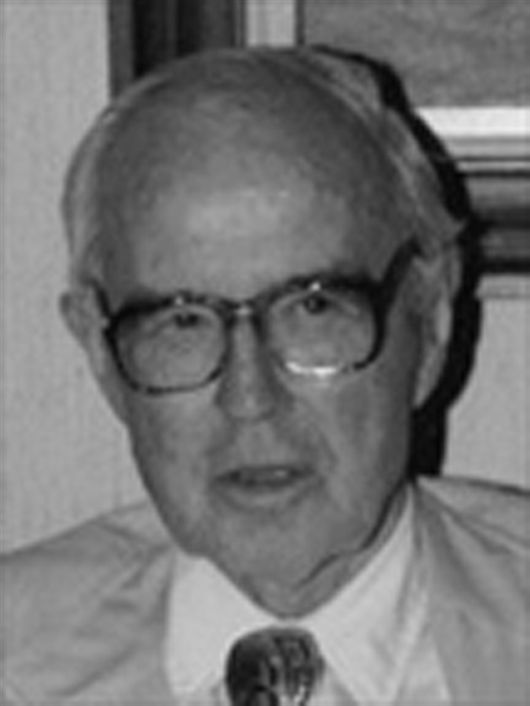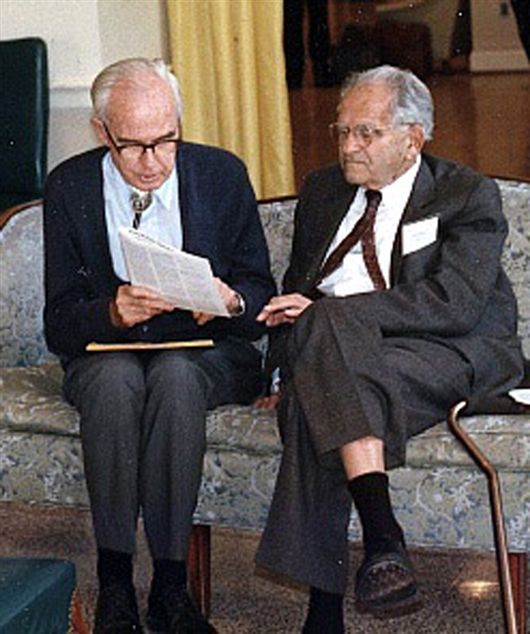博文
物理学家、1955年诺贝尔物理学奖得主W. E. Lamb Jr.去世
 精选
精选
||
在Arizona大学光科学研究中心(center of optical sciences)的网站查资料的时候,突然发现物理学家、1955年诺贝尔物理学奖得主 Lamb在5月15日去世了。物理系毕业的我,物理学的并不好,如果不翻书对于Lamb的了解也仅限于Lamb 移动、精细结构等名词。5.12以后,心里一直牵挂着汶川地震的信息,不料此时一位世界级的物理学大家也与世长辞。
愿逝者长眠,生者健康!
以下内容转自美国ARIZONA大学网站
Willis E. Lamb Jr., 1955 Nobel Laureate in Physics, Dies at 94
Lamb received top honors for his towering contributions in quantum physics

Nobel laureate Willis E. Lamb Jr., 94, University of Arizona Regents' Professor emeritus of physics and optical sciences, died of complications arising from a gallstone disorder early Thursday, May 15, at University Medical Center.
Dr. Lamb joined The University of Arizona in 1974. He received a 1955 Nobel Prize in physics for his experimental work on the fine structure of the hydrogen atom and for the discovery of the phenomenon known as the Lamb Shift, which revolutionized the quantum theory of matter.
"In many respects, his Nobel Prize and National Medal of Science were more important to others than they were to him," said Elsie Wattson Lamb, who met Lamb 27 years ago and married him on Jan. 26, 2008. "Even after retirement, he remained in the present and forward-looking, concerned that what he was doing should have some value.
"His fondest life memories were two -- his years at New College, Oxford University, and his summer trips to the Lindau Nobel Laureate Meetings, a gathering of Nobel laureates and talented young students held annually at Lindau on Lake Constance. We were planning to attend the Lindau meeting this summer," Mrs. Lamb said.
"Clearly, he was a brilliant and serious scientist," she added. "But he was also deeply human. He was a man of exquisite, subtle wit and a tenacious joie de vivre."
Born July 12, 1913, in Los Angeles, Lamb graduated from public high school in LA with an interest in mathematics, physics and chemistry. He enrolled in the University of California at Berkeley in 1930, where he earned a bachelor's degree in chemistry (1934).
He continued at Berkeley as a graduate student in theoretical physics. His thesis research was directed by J. Robert Oppenheimer, an extraordinary teacher and theoretician who a few years later, in 1942, was appointed by President Roosevelt to head the Manhattan Project that created the atomic bomb. Lamb was awarded his doctoral degree in 1938 for his dissertation on the electromagnetic properties of nuclear systems.
He joined the Columbia University physics faculty in 1938. From 1943 to 1951, he worked with the Columbia Radiation Laboratory. There his defense-related research focused on the problem of how to make shorter, higher frequency microwave sources for radar – and it led to his Nobel Prize-winning work.
"I was teaching a summer session course on spectroscopy at Columbia in 1945 and remember Aug. 8, the day the bombing of Hiroshima was announced," Lamb recalled in an interview in 2000, when he received the National Medal of Science, the nation's highest scientific honor.
"In teaching this course, I read a book that mentioned that German researchers in the 1930s had thought that hydrogen atoms would respond to three centimeter-wavelength radiation, the same radiation I worked with in the lab."
Because of the war, Lamb had no way to contact the German scientists, who had disappeared. But he knew how to make the necessary radiation, and in the summer of 1946 he conceived a difficult experiment to study the fine structure of optical radiation from hydrogen with very high resolution radio frequency resonance methods. He designed and built the apparatus with R. C. Retherford, a Columbia University graduate student.
"The apparatus I used was a combination of metal and glass. You might say the hydrogen atoms went in one end and came out the other end, and in between you did things with them involving microwaves and a magnetic field. The whole thing sat on a table maybe eight feet long."
In April 1947 – "I remember it was on a Saturday," Lamb said – his experiment succeeded. It revealed the minute but significant shift of energy in the hydrogen atom in different states.
Two months later, he was invited to present his work at a historically famous conference on Shelter Island, N.Y., a conference subsidized by the National Academy of Sciences to explore directions for research in the post-war era.
Prior to Lamb's discovery, physicists knew that some states of the hydrogen atom had well defined energy levels. The accepted theories predicted that certain distinct states would have precisely the same energies when the atom was activated. But physicists were puzzled when other calculations suggested that these energies might differ by tiny amounts, while the experimental evidence was unclear.
Lamb's discovery of the quantum effect that became known as the "Lamb shift" led physicists to rethink the basic concepts behind the application of quantum theory to electromagnetism. His work became one of the foundations of quantum electrodynamics, a key aspect of modern elementary particle physics.
Lamb wrote a series of remarkable papers published in the Physical Review from 1947-1953 that were regarded as immediate classics by all working in atomic physics, said UA physics professor William H. Wing. Wing said that when he began graduate studies at the University of Michigan in 1962, he was handed that set of Lamb's papers as a starting point for learning modern atomic physics. Wing did post-doctoral research supervised by Lamb at Yale, was appointed to the Yale faculty and then joined Lamb in the move to Arizona in 1974.
Lamb retired from UA in 2002. He and friends established the Willis Lamb Jr. Scholarship in optical sciences. The scholarship was awarded to an optical sciences graduate student for the first time a few weeks ago. Donations made to this scholarship will assist the College of Optical Sciences to fully fund two doctoral student scholarships, Mrs. Lamb said.
Lamb remained close friends with several former students, who include UA professor emeritus of optical sciences Murray Sargent III of Microsoft Corp., former UA optical sciences professor Marlan O. Scully , now of Texas A & M and Princeton universities, Heidi Fearn of California State University Fullerton, and Lionel N. Menegozzi, a former member of the UA physics faculty.
In addition to his widow, Elsie Wattson Lamb, Lamb is survived by a brother, Perry, who lives in Maine.
Degrees:
• B. S. in Chemistry, University of California, Berkeley, 1934
• Ph. D. in Physics, University of California, Berkeley, 1938
• D. Sc., (honorary), University of Pennsylvania, 1953
• M. A. (by decree), Oxford University, 1956
• M. A. (by decree), Yale University, 1961
• L. H. D. (honorary), Yeshiva University, 1965
• D. Sc. (honorary), Gustavus Adolphus College, 1975
• D. Sc., (honorary), Columbia University, 1990
• D. rer. nat. h. c., University of Ulm, 1997
Academic Positions:
• Instructor and member of faculty of Columbia University, 1938-1948
• Professor of Physics, Columbia University, 1948-1952
• Professor of Physics, Stanford University, 1951-1956
• Wykeham Professor of Physics, and Fellow of New College, Oxford University, 1956-1962
• Henry Ford II Professor of Physics, Yale University, 1962-1972
• J. Willard Gibbs Professor of Physics, Yale University, 1972-1974
• University of Arizona: Professor of Physics and Optical Sciences, 1974 - ; Professor in the Arizona Research Laboratories, 1982 - ; Regents Professor, 1990 –
Visiting Positions:
• Morris Loeb Lecturer, Harvard University, 1953-54
• Summer Lecturer, University of Colorado, 1959
• Visiting Professor of Japan Society for the Promotion of Science, at Research Institute for Fundamental Research, Kyoto University, 1960
• Visiting Professor, Tata Institute of Fundamental Research, Bombay, 1960
• Visiting Professor of Physics, Columbia University, 1961
• Lecturer, International School of Physics, "Enrico Fermi," Varenna, 1963
• Fulbright Lecturer, University of Grenoble, (Les Houches), 1964
• Gordon Shrum Lecturer, Simon Fraser University, 1972
• Vikram Sarabhai Professor, Physics Research Laboratory, Ahmedabad, India, 1997.
Awards and Memberships:
• Rumford Premium, American Academy of Arts and Sciences, 1953
• Research Corporation Award, 1955
• Nobel Prize in Physics, 1955
• Guthrie Award, Physical Society (London), 1958
• Guggenheim Fellowship, 1960-1961
• Yeshiva University Award, 1962
• Fellow, American Physical Society (Board of Editors, 1949-1951)
• Member, National Academy of Sciences, 1954
• Honorary Fellow, Institute of Physics and Physical Society, 1962
• Member, Scientific Council Belfer Graduate School, Yeshiva University, 1963-1968
• Fellow, Optical Society of America, 1976-1980
• Honorary Life Member of New York Academy of Sciences, 1979
• Honorary Fellow, Royal Society of Edinburgh, 1981
• Senior Fellowship, Alexander von Humboldt Foundation, 1992-1994
• Einstein Medal, Society for Optical and Quantum Electronics, 1992
• Center for Philosophy of Science, London School for Economics, 1993 -
• President's National Medal for Science, 2000

With Dr. Wigner
https://wap.sciencenet.cn/blog-3176-25887.html
上一篇:捐款知多少
下一篇:很有意思的一句话
全部作者的精选博文
全部作者的其他最新博文
全部精选博文导读
相关博文
- • 聚英才 建高地 | 北京理工大学“特立青年学者”全球招聘开启
- • 700年后日本或濒临灭绝?日本学者推算预测:届时或仅剩1名15岁以下孩子
- • [转载]【同位素视角】非英语母语学者如何区分’e.g.’, ‘i.e.’, ‘namely’与‘such as’等混淆难题
- • 美国佐治亚大学等机构学者:刈割策略对Bulldog 805紫花苜蓿+Tifton 85狗牙根混播草地产量及品质的影响
- • 美国堪萨斯州立大学、密苏里大学等机构学者研究成果:土壤水分管理策略和品种多样性对紫花苜蓿产量、营养品质和农场盈利能力的影
- • 德国、捷克草业科学学者长期放牧实验:异质草地斑块中的土壤有机碳储量和地下生物量